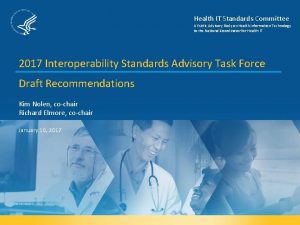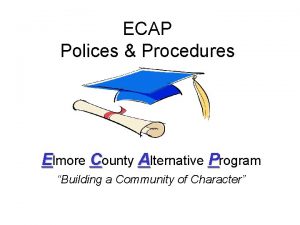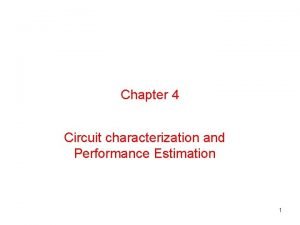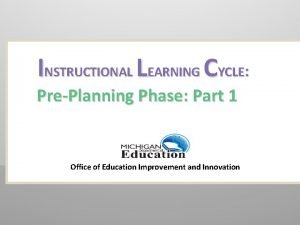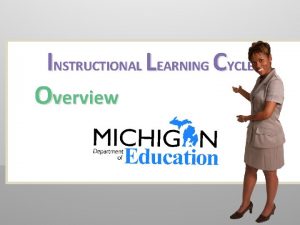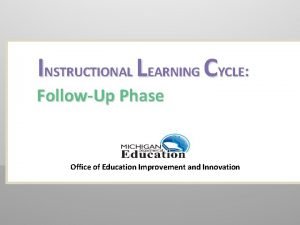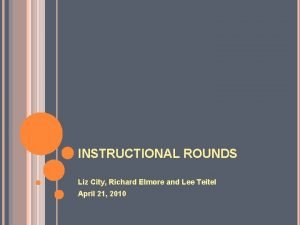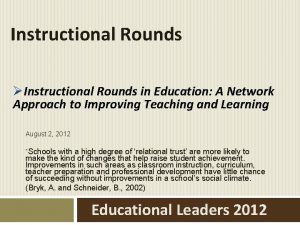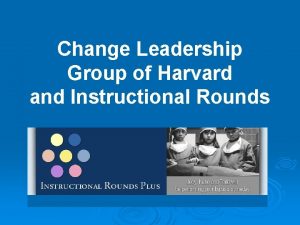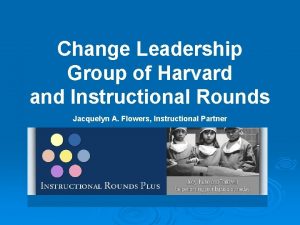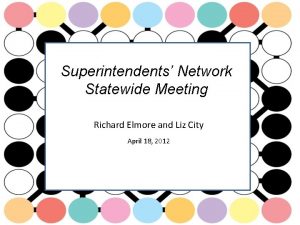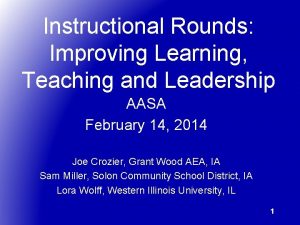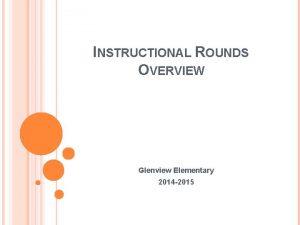Learning Through Instructional Rounds Richard F Elmore Harvard











- Slides: 11

Learning Through Instructional Rounds Richard F. Elmore Harvard University Iowa Leadership Academy April 2012

Instructional Rounds is a Learning Practice

Why Rounds? • Build Professional Community • Develop a Common Language for Understanding and Analyzing Instructional Practice • Develop a Culture of Shared Practice • Develop Collective Efficacy Around Improvements in Student Learning • Build Common Understanding of System-, School. Level Improvement Strategies

THE INSTRUCTIONAL CORE • Principle #1: Increases in student learning occur only as a consequence of improvements in the level of content, teachers’ knowledge and skill, and student engagement. CONTENT • Principle #2: If you change one element of the instructional core, you have to change the other two. • Principle #3: If you can’t see it in the core, it’s not there. TASK • Principle #4: Task predicts performance. TEACHER STUDENT • Principle #5: The real accountability system is in the tasks that students are asked to do. • Principle #6: We learn to do the work by doing the work. • Principle #7: Description before analysis, analysis before prediction, prediction before evaluation.

THE ROUNDS PROCESS PROBLEM OF PRACTICE PRESCRIPTION C PREDICTION OBSERVATION T S ANALYSIS

Using Descriptive Language Specificity Descriptive Objectivity Judgmental Specific General “The choice of Huckleberry Finn as text was inappropriate for this age group” “The teacher did a fabulous job of holding the students’ attention” “At about three minutes into the lesson, the teacher asked two students to respond to the question, “Why did Huck decide to leave? ” “The teacher introduced a writing prompt”

COMPARISON OF ROUNDS AND WALKTHROUGHS ROUNDS WALK-THROUGHS • ADDRESS A PROBLEM OF PRACTICE • CHECK FOR IMPLEMENTATION OF DISTRICT PRIORITIES • DESCRIPTIVE-ANALYTIC MODE • NORMATIVE MODE • DEVELOP COMMON NORMS OF PRACTICE • ASSESS PRESENCE-ABSENCE OF PRACTICES • DIAGNOSTIC-INFERENTIALPREDICTIVE • EVALUATIVE

Who Should Play? • It Depends. . . • Leadership Networks– Build Competency Around Instructional Practice • Vertical, Cross-Role Networks– Build Common Culture of Instruction Across Levels • Within-School Networks– Build Common Practice, Commitments • Cross-School, Cross-System Networks– Share Practices Among Professionals in Different Settings

IMPROVEMENT PROCESSES P/Q T

PROFESSIONAL NETWORKS BUILD COMMITMENT AND LATERAL ACCOUNTABILITY

Conditions for Effective Rounds Practice • A Clear and Explicit Instructional Improvement Strategy: What, Why, How? • Clear Norms of Confidentiality and Trust • NO Use of Rounds for Evaluation • Commitments/Lateral Accountability • Willingness to Challenge Existing Beliefs and Practices • Practice, Practice

